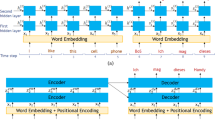Abstract
Chaotic dynamics introduced in a recurrent neural network model is applied to controlling an object to track a moving target in two-dimensional space, which is set as an ill-posed problem. The motion increments of the object are determined by a group of motion functions calculated in real time with firing states of the neurons in the network. Several cyclic memory attractors that correspond to several simple motions of the object in two-dimensional space are embedded. Chaotic dynamics introduced in the network causes corresponding complex motions of the object in two-dimensional space. Adaptively real-time switching of control parameter results in constrained chaos (chaotic itinerancy) in the state space of the network and enables the object to track a moving target along a certain trajectory successfully. The performance of tracking is evaluated by calculating the success rate over 100 trials with respect to nine kinds of trajectories along which the target moves respectively. Computer experiments show that chaotic dynamics is useful to track a moving target. To understand the relations between these cases and chaotic dynamics, dynamical structure of chaotic dynamics is investigated from dynamical viewpoint.














Similar content being viewed by others
References
Aihara K, Takabe T, Toyoda M (1990) Chaotic neural networks. Phys Lett A 114:333–340
Babloyantz A, Destexhe A (1986) Low-dimensional chaos in an instance of epilepsy. Proc Natl Acad Sci USA 83:3513–3517
Fujii H, Itoh H, Ichinose N, Tsukada M (1996) Dynamical cell assembly hypothesis—theoretical possibility of spatio-temporal coding in the cortex. Neural Netw 9:1303–1350
Huber F, Thorson H (1985) Cricket auditory communication. Sci Amer 253:60–68
Hülse M, Pasemann F (2002) Dynamical neural Schmitt trigger for robot control. In: Dorronsoro J (ed) ICANN 2002: topics in artificial neural networks. International Conference On Artificial Neural Networks, Madrid, Spain, August 28–30, 2002. Lecture notes in computer science, vol 2415. Springer Verlag, Berlin, pp 783–788
Kaneko K, Tsuda I (2003) Chaotic itinerancy. Chaos 13(3):926–936
Kuroiwa J, Nara S, Aihara K (1999) Functional possibility of chaotic behaviour in a single chaotic neuron model for dynamical signal processing elements. In: 1999 IEEE International Conference on Systems, Man, and Cybernetics (SMC’99), Tokyo, October, 1999, vol 1. p 290
Nara S (2003) Can potentially useful dynamics to solve complex problems emerge from constrained chaos and/or chaotic itinerancy? Chaos 13(3):1110–1121
Nara S, Davis P (1992) Chaotic wandering and search in a cycle memory neural network. Prog Theor Phys 88:845–855
Nara S, Davis P (1997) Learning feature constraints in a chaotic neural memory. Phys Rev E 55:826–830
Nara S, Davis P, Kawachi M, Totuji H (1993) Memory search using complex dynamics in a recurrent neural network model. Neural Netw 6:963–973
Nara S, Davis P, Kawachi M, Totuji H (1995) Chaotic memory dynamics in a recurrent neural network with cycle memories embedded by pseudo-inverse method. Int J Bifurcation and Chaos Appl Sci Eng 5:1205–1212
Nicolelis M (2001) Actions from thoughts. Nature 409:403–407
Skarda CA, Freeman WJ (1987) How brains make chaos in order to make sense of the world. Behav Brain Sci 10:161–195
Suemitsu Y, Nara S (2003) A note on time delayed effect in a recurrent neural network model. Neural Comput Appl 11(3&4):137–143
Suemitsu Y, Nara S (2004) A solution for two-dimensional mazes with use of chaotic dynamics in a recurrent neural network model. Neural Comput 16(9):1943–1957
Tsuda I (1991) Chaotic itinerancy as a dynamical basis of hermeneutics in brain and mind. World Futures 32:167–184
Tsuda I (2001) Toward an interpretation of dynamic neural activity in terms of chaotic dynamical systems. Behav Brain Sci 24(5):793–847
Wessberg J, Stambaugh C, Kralik J, Beck P, Laubach M, Chapin J, Kim J, Biggs S, Srinivasan M, Nicolelis M (2000) Real-time prediction of hand trajectory by ensembles of cortical neurons in primates. Nature 408:361–365
Author information
Authors and Affiliations
Corresponding author
Rights and permissions
About this article
Cite this article
Li, Y., Nara, S. Novel tracking function of moving target using chaotic dynamics in a recurrent neural network model. Cogn Neurodyn 2, 39–48 (2008). https://doi.org/10.1007/s11571-007-9029-6
Received:
Accepted:
Published:
Issue Date:
DOI: https://doi.org/10.1007/s11571-007-9029-6




